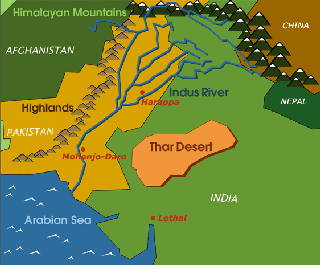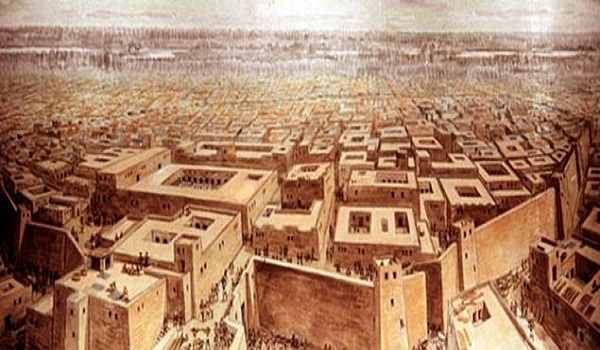Annalee Newitz
The Harappan civilization dominated the Indus River valley beginning about five thousand years ago, many of its massive cities sprawling at the edges of rivers that still flow through Pakistan and India today. But its culture remains a mystery. Why did it leave behind no representations of great leaders, nor of warfare?
Archaeologists have long wondered whether the Harappan civilization could actually have thrived for roughly 2,000 years without any major wars or leadership cults. Obviously people had conflicts, sometimes with deadly results — graves reveal ample skull injuries caused by blows to the head. But there is no evidence that any Harappan city was ever burned, besieged by an army, or taken over by force from within. Sifting through the archaeological layers of these cities, scientists find no layers of ash that would suggest the city had been burned down, and no signs of mass destruction. There are no enormous caches of weapons, and not even any art representing warfare.
That would make the Harappan civilization an historical outlier in any era. But it’s especially noteworthy at a time when neighboring civilizations in Mesopotamia were erecting massive war monuments, and using cuneiform writing on clay tablets to chronicle how their leaders slaughtered and enslaved thousands.
What exactly were the Harappans doing instead of focusing their energies on military conquest?

The Harappan People
The Indus River flows out of the Himalayas, bringing fresh water to the warm, dry valley where the ancient city of Harappa first began to grow. The Harappan civilization is the namesake of this city, located between two rivers, whose arts, written language, and science spread to several other large, riverside cities in the area. Mohenjo-Daro was the largest of these cities with a population of roughly 80,000 people. Archaeologists have recently analyzed the teeth of people buried in Mohenjo-Daro’s graveyards, searching for telltale chemical traces that reveal where these people drank water as children. They discovered that many had grown up drinking water from elsewhere in the region, meaning that a lot of the city’s inhabitants were migrants who had come to the city as adults.

Art from Harappan cities also attests to a very mixed population, with statues showing people who sport a wide variety of clothing and hair styles. So the Harappans appear to have been a very diverse lot. Some traveled far from their cities, probably by boat across the Persian Gulf, to trade with other great civilizations in the region during the 2000s BCE. There was at least one Harappan trade outpost in Mesopotamia, in the city of Eshnunna, which today lies about 30 km northeast of Baghdad. People from other Mesopotamian cities like Ur owned distinctively Harappan luxury goods such as beads and tiny carved bones.
Harappans appear to have been traders who welcomed people to their cities from pretty much anywhere. But that doesn’t mean they were disorganized or anarchic.
Standard Measures and Writing

By studying the layers of built environments in Harappa, archaeologists have pieced together a fragmentary history of the civilization’s rise. Harappa began as a village, probably about 6,000 years ago. There’s evidence of agriculture and very early pottery throughout the 3000s BCE.
It’s also during this time that we begin to see markings that look like writing on pottery. Over a period of just a couple of centuries, these crude marks evolved quickly into an alphabet that we still can’t decipher. Here you can see a typical example of Harappan writing, on a seal that would have been pressed into soft clay, and was probably used in trade.

Indeed, it seems that writing in Harappa followed soon after the invention of standard weights and measures for commerce. Archaeologists have unearthed hundreds of blocks in a variety of standard sizes that conform to the binary weight system favored in the Indus Valley.
This fits with most accounts of how writing emerges in civilizations. Often, it begins with people using numbers and math to determine who owns what, or who has bought what from whom. From there, it develops quickly into a full-blown system of symbols. Writing seems to be one of those technological innovations that evolves very rapidly once people start using it.
It’s next to impossible to build an urban civilization without standard measures and writing, but it’s rare that we have a chance to look back in history to glimpse a literate culture emerging from a pre-literate one. In the ruins of Harappa, we can track that transition taking place. And the more writing we see in a given layer, the more complicated and advanced the civilization had become.
Advanced Technologies and Civil Engineering
Harappans didn’t just create standardized measures — they liked everything to be standardized, right down to the size of the bricks they used to build their homes. Bricks and boards, like weights, came in just a few standard sizes. Echoing this love of order, Harappans built their cities on fairly strict grids.

Above is a sketch of the city plan of Mohenjo-Daro, based on what we’ve been able to reconstruct from ruins. There are several wide promenades — large enough for two carts to drive side-by-side — that passed through the city, then out of the gates and into the farmlands beyond.


